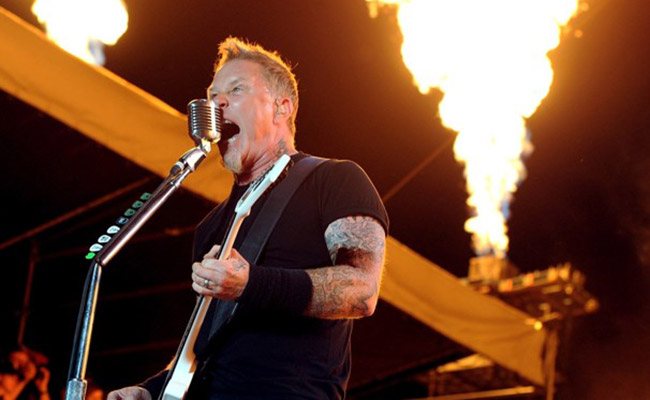
“This is pain I’ve never felt in my whole life, and it won’t go away.”
James Hetfield and his Metallica bandmates ended their Lollapalooza set on Saturday to a cheering crowd with the final notes of “Enter Sandman.” It was a far different and better ending than their Aug. 8, 1992, show in Montreal, which would end in millions of dollars worth of damage, dozens of arrests, and Hetfield visiting the hospital burn ward.
Metallica was entering their commercial peak in 1992, riding the wave of their Black Album, a record that would eventually go platinum 16 times. A co-headlining bill with Guns N’ Roses, featuring Faith No More, Motörhead, and Body Count as openers, guaranteed crowds would be treated to seven hours of heavy-metal riffing. Except on the eighth stop of the 25-city tour.
A 12-Foot Tower Of Fire
Metallica was only three songs into their 18-song set list when things went horribly wrong. Prior to the show, the band’s pyro technician told the band that magnesium flashes would be on the outside wings of the stage, but neglected to inform them about the pyro already in place. This resulted in Hetfield literally stepping into a 12-foot torch of fire estimated to be around 3,200 degrees during the intro to “Fade to Black.” Hetfield explained that he was confused as to where exactly he thought he needed to be on stage when the disaster struck.
“During ‘Fade to Black,’ I’m up there playing the part, you know, and these colored flames are going off. I’m a little confused on where I’m supposed to be. I walk forward, I walk back, the pyro guy doesn’t see me and ‘whoosh’ a big colored flame goes right up under me. I’m burnt — all my arm, my hand completely, down to the bone. The side of my face, hair’s gone. Part of my back. I watched the skin just rising, things going wrong.”
A stage hand quickly rushed over and dumped a bucket of cool water on the frontman, but the relief was short-lived with Hetfield feeling a pain worse than anything he’d known before. The set was cut short with Lars explaining to the crowd what had happened and promising to return. Meanwhile, Hetfield was backstage waiting to be taken to the hospital for treatment for his second- and third-degree burns, when a security guard mistakenly bumped into his burnt hand. “I remember I just lost it,” explained Hetfield. “I screamed and punched him right in the nuts [laughs].”
Cue The Chaos
To make matters worse, Guns N’ Roses refused to play earlier than their scheduled time, despite Metallica having to end their set early, and cut their own set short. The band had already canceled several dates and caused a riot at a St. Louis show a year earlier. When GNR finally took the stage, two hours after the Metallica accident, the crowd was pissed off, and so was Axl Rose. Complaining of vocal-cord problems, they finished “Bad Obsession” before Rose told the crowd, “In case anybody here is interested, this will be our last show for a long time.”
That’s when all hell broke loose. The Montreal crowd began to riot and destroy everything in sight. Garbage cans were set on fire, concession stands were overturned, and then trouble spilled out into the streets, where a police cruiser was overturned and a street lamp was uprooted. When police and security were finally able to quell the heavy-metal melee, $400,000 in property damage had been done, with 10 people injured and at least a dozen being arrested.
The Montreal show would prove to be one of the most infamous concerts of the 1990s, and the tour was postponed until Aug. 25, when Metal Church guitar player John Marshall took over Hetfield’s guitar duties. Metallica would eventually return to using pyrotechnics, but one has to assume that Hetfield is likely a little more leery of where he stands on stage. Oh, and Metallica did make good on their promise to finish the show when they returned to Montreal in February 1993.
(Via Montreal Gazette)
